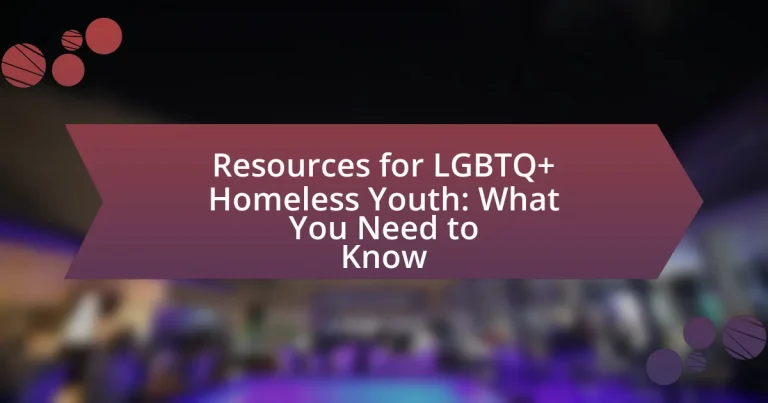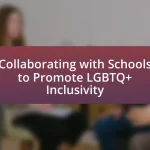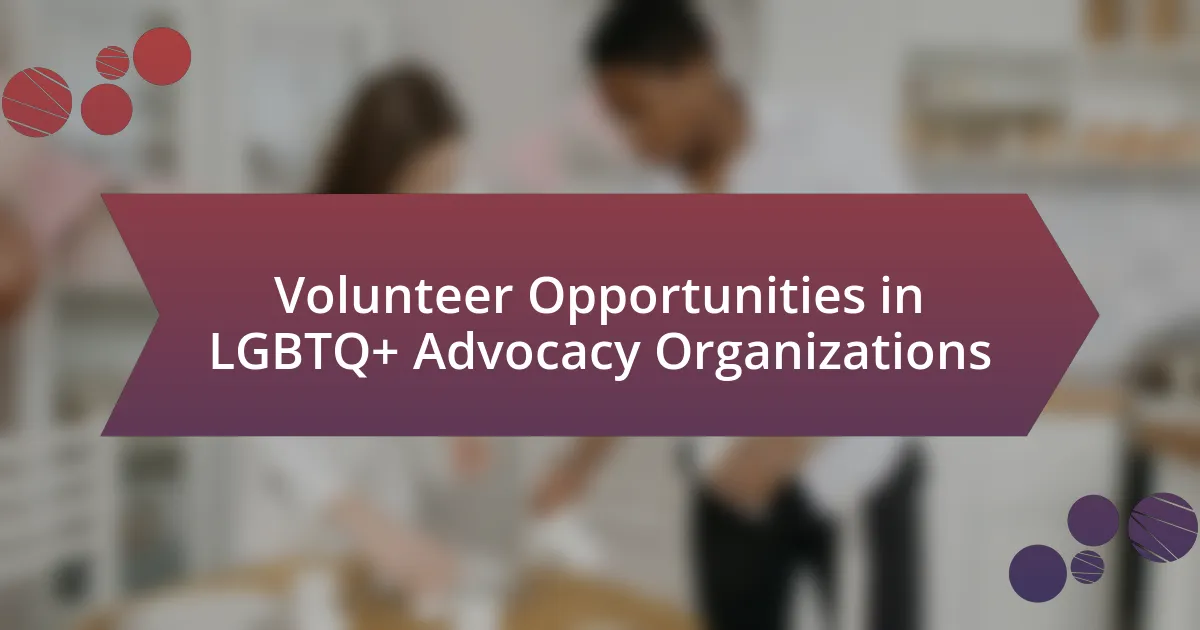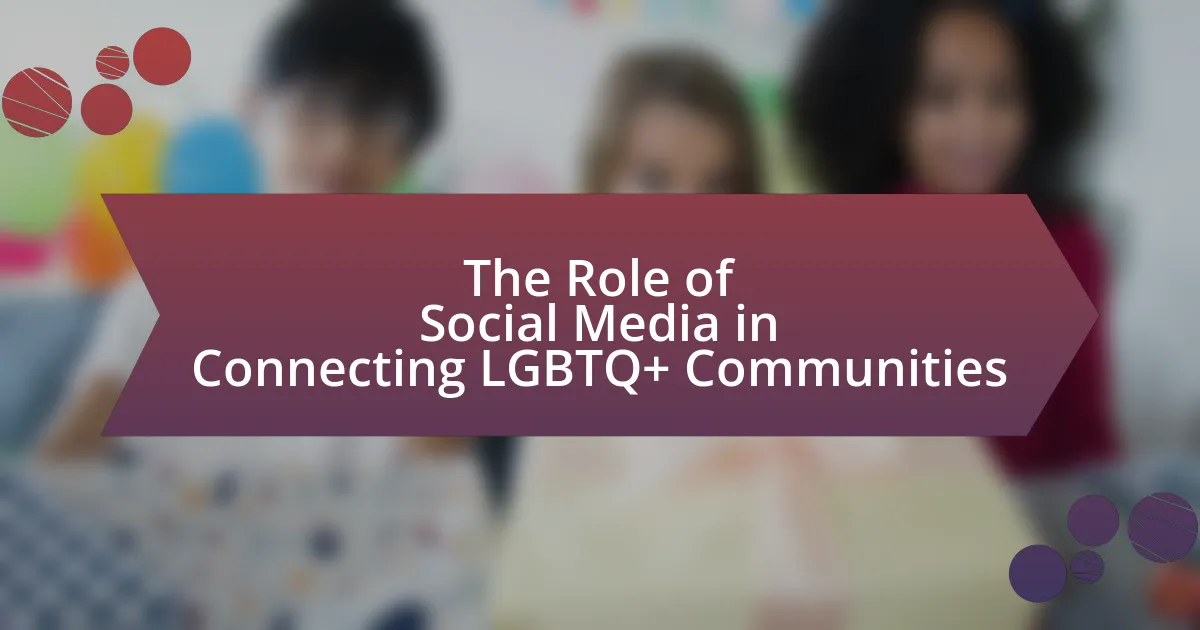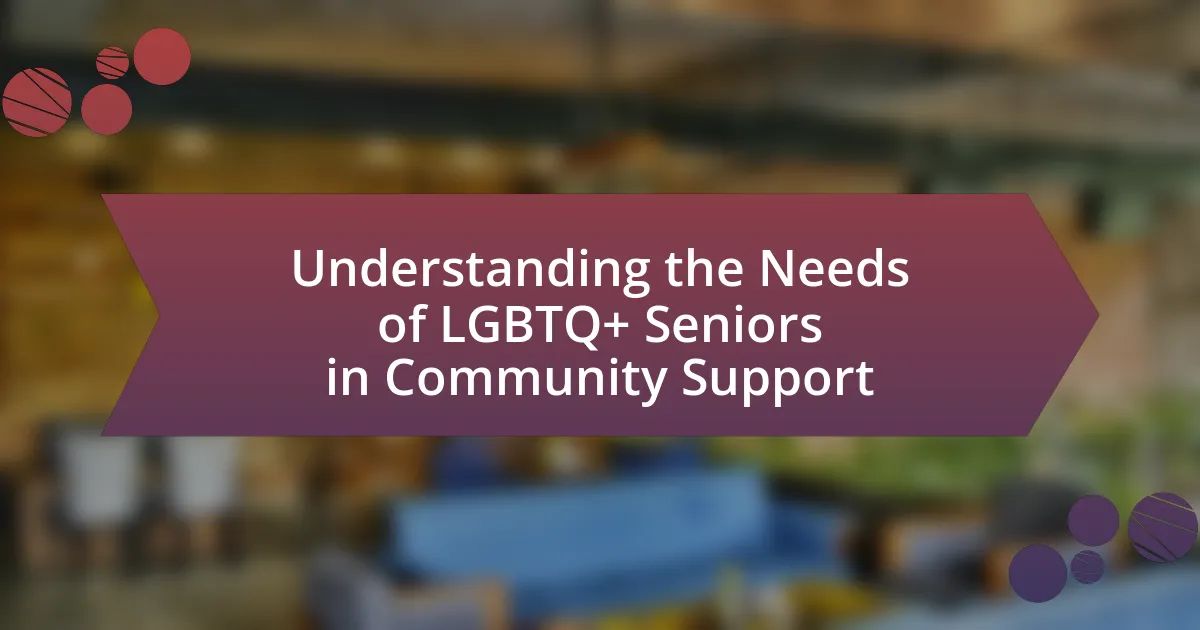The article focuses on the critical issue of resources available for LGBTQ+ homeless youth, highlighting the unique challenges they face, such as discrimination, family rejection, and mental health issues. It discusses the factors leading to homelessness in this demographic, including economic instability and societal attitudes, and emphasizes the heightened vulnerabilities they experience, such as violence and substance abuse. Additionally, the article outlines various support services, shelters, and advocacy organizations that cater specifically to LGBTQ+ youth, detailing eligibility requirements and best practices for accessing these resources. It also addresses common misconceptions about LGBTQ+ homeless youth and suggests ways to educate the public on these pressing issues.

What are the key challenges faced by LGBTQ+ homeless youth?
LGBTQ+ homeless youth face several key challenges, including discrimination, lack of access to safe housing, and mental health issues. Discrimination from family, peers, and service providers often leads to rejection and isolation, exacerbating their homelessness. Many LGBTQ+ youth experience difficulty finding shelters that are safe and affirming of their identities, which limits their options for stable housing. Additionally, high rates of mental health issues, such as depression and anxiety, are prevalent among this population, often stemming from societal stigma and trauma. According to a study by the Williams Institute, LGBTQ+ youth are 120% more likely to experience homelessness than their heterosexual counterparts, highlighting the severity of these challenges.
How does homelessness specifically impact LGBTQ+ youth?
Homelessness significantly impacts LGBTQ+ youth by increasing their vulnerability to violence, mental health issues, and substance abuse. Studies indicate that LGBTQ+ youth experience higher rates of homelessness compared to their heterosexual peers, with estimates suggesting that up to 40% of homeless youth identify as LGBTQ+. This demographic faces unique challenges, including discrimination and rejection from family, which exacerbates their risk of mental health disorders such as depression and anxiety. Additionally, the lack of safe housing options often leads LGBTQ+ youth to engage in survival sex or substance use as coping mechanisms, further endangering their well-being.
What unique vulnerabilities do LGBTQ+ homeless youth experience?
LGBTQ+ homeless youth experience unique vulnerabilities such as increased risk of violence, mental health issues, and discrimination. These vulnerabilities stem from societal stigma and rejection, often leading to higher rates of physical and sexual abuse compared to their heterosexual peers. Research indicates that LGBTQ+ youth are 120% more likely to experience homelessness due to family rejection, and they face significant barriers in accessing safe shelters, which may not be affirming of their identities. Additionally, studies show that 40% of homeless youth identify as LGBTQ+, highlighting the disproportionate impact of homelessness on this population.
How do societal attitudes contribute to these challenges?
Societal attitudes significantly contribute to the challenges faced by LGBTQ+ homeless youth by fostering stigma and discrimination. Negative perceptions often lead to family rejection, which is a primary cause of homelessness among LGBTQ+ individuals; studies indicate that approximately 40% of homeless youth identify as LGBTQ+, largely due to familial and societal rejection. Furthermore, societal attitudes can perpetuate systemic inequalities, limiting access to resources such as housing, healthcare, and employment opportunities for LGBTQ+ youth. This systemic discrimination is evidenced by research from the Williams Institute, which highlights that LGBTQ+ youth experience higher rates of mental health issues and victimization, exacerbating their vulnerability and homelessness.
What factors lead to homelessness among LGBTQ+ youth?
Factors leading to homelessness among LGBTQ+ youth include family rejection, discrimination, and economic instability. Family rejection occurs when LGBTQ+ youth face hostility or lack of acceptance from their families, often resulting in them being forced to leave home. Discrimination in schools and communities can lead to bullying and social isolation, further exacerbating their vulnerability. Economic instability arises from limited job opportunities and lack of access to supportive resources, making it difficult for these youth to secure stable housing. According to a study by the Williams Institute, approximately 40% of homeless youth identify as LGBTQ+, highlighting the significant impact of these factors on their living situations.
How do family rejection and discrimination play a role?
Family rejection and discrimination significantly contribute to the challenges faced by LGBTQ+ homeless youth. Research indicates that approximately 40% of homeless youth identify as LGBTQ+, often due to family rejection stemming from their sexual orientation or gender identity. This rejection can lead to mental health issues, increased vulnerability to exploitation, and a lack of access to essential resources. Studies show that LGBTQ+ youth who experience family rejection are more likely to engage in risky behaviors and face higher rates of homelessness compared to their heterosexual peers. Thus, family rejection and discrimination are critical factors that exacerbate the homelessness crisis among LGBTQ+ youth.
What economic factors contribute to homelessness in this demographic?
Economic factors contributing to homelessness among LGBTQ+ youth include high rates of unemployment, discrimination in the job market, and lack of affordable housing. Studies indicate that LGBTQ+ individuals often face barriers to employment due to bias, leading to increased financial instability. For instance, a report by the Williams Institute found that LGBTQ+ youth are more likely to experience job discrimination, which exacerbates their economic vulnerability. Additionally, the rising cost of housing, coupled with lower average incomes for LGBTQ+ individuals, further limits their ability to secure stable living conditions.

What resources are available for LGBTQ+ homeless youth?
LGBTQ+ homeless youth can access various resources, including shelters, support services, and advocacy organizations. For instance, the True Colors United provides resources specifically tailored for LGBTQ+ youth experiencing homelessness, focusing on prevention and support. Additionally, the Trevor Project offers crisis intervention and suicide prevention services for LGBTQ+ youth, ensuring they have access to mental health support. According to a 2021 report by the Williams Institute, LGBTQ+ youth are 120% more likely to experience homelessness than their heterosexual peers, highlighting the critical need for these specialized resources.
What types of shelters and housing programs exist for LGBTQ+ youth?
Various types of shelters and housing programs exist for LGBTQ+ youth, including emergency shelters, transitional housing, and supportive housing programs. Emergency shelters provide immediate, short-term accommodation for youth facing homelessness, often with a focus on safety and acceptance for LGBTQ+ individuals. Transitional housing programs offer longer-term support, typically ranging from several months to a few years, allowing youth to gain stability while receiving services such as counseling and job training. Supportive housing programs combine affordable housing with supportive services, helping LGBTQ+ youth maintain independence while addressing their unique needs. According to the 2021 report by the Williams Institute, LGBTQ+ youth are disproportionately represented among homeless youth, highlighting the critical need for these specialized housing resources.
How do these shelters cater specifically to LGBTQ+ needs?
Shelters cater specifically to LGBTQ+ needs by providing safe, inclusive environments that respect and affirm diverse sexual orientations and gender identities. These shelters often implement anti-discrimination policies, offer specialized support services such as counseling tailored to LGBTQ+ experiences, and create programming that fosters community and belonging among LGBTQ+ youth. For instance, a study by the Williams Institute found that LGBTQ+ youth are disproportionately represented in the homeless population, highlighting the necessity for shelters to address their unique challenges through targeted resources and support systems.
What are the eligibility requirements for these programs?
The eligibility requirements for programs supporting LGBTQ+ homeless youth typically include being between the ages of 12 and 24, identifying as LGBTQ+, and experiencing homelessness or housing instability. Many programs also require participants to demonstrate a need for services, such as access to shelter, food, or mental health support. Additionally, some programs may have specific criteria related to income level or residency within a certain geographic area. These requirements ensure that resources are directed to those who are most in need within the LGBTQ+ homeless youth community.
What support services are offered to LGBTQ+ homeless youth?
Support services offered to LGBTQ+ homeless youth include emergency shelters, transitional housing, mental health counseling, and case management. These services are designed to provide safe living environments, emotional support, and assistance in accessing education and employment opportunities. For instance, organizations like the Ali Forney Center in New York City specifically cater to LGBTQ+ youth, offering shelter and comprehensive support services tailored to their unique needs. Additionally, the National Network for Youth reports that LGBTQ+ youth are disproportionately represented among the homeless population, highlighting the necessity for targeted support services that address their specific challenges.
How do mental health services address the needs of LGBTQ+ youth?
Mental health services address the needs of LGBTQ+ youth by providing specialized support that acknowledges their unique experiences and challenges. These services often include culturally competent therapy, peer support groups, and crisis intervention tailored to the specific issues faced by LGBTQ+ individuals, such as discrimination, family rejection, and identity struggles. Research indicates that LGBTQ+ youth are at a higher risk for mental health issues, with studies showing that they experience higher rates of depression and anxiety compared to their heterosexual peers. For example, the 2019 National Youth Risk Behavior Survey found that 40% of LGBTQ+ youth reported feeling sad or hopeless, highlighting the critical need for targeted mental health interventions.
What role do community organizations play in providing resources?
Community organizations play a crucial role in providing resources to LGBTQ+ homeless youth by offering essential services such as shelter, food, mental health support, and advocacy. These organizations often create safe spaces that cater specifically to the unique needs of LGBTQ+ individuals, addressing issues like discrimination and social stigma. For instance, studies show that organizations like The Trevor Project and Covenant House provide targeted programs that significantly improve the well-being and stability of LGBTQ+ youth experiencing homelessness. By mobilizing community support and resources, these organizations help bridge the gap between vulnerable youth and the services they require for survival and empowerment.

How can LGBTQ+ homeless youth access these resources?
LGBTQ+ homeless youth can access resources through specialized organizations and shelters that cater to their unique needs. Many cities have LGBTQ+-specific shelters, such as the Ali Forney Center in New York City, which provides safe housing and support services. Additionally, national organizations like the Trevor Project offer crisis intervention and mental health resources. According to a 2020 report by the Williams Institute, LGBTQ+ youth are 120% more likely to experience homelessness than their heterosexual peers, highlighting the importance of targeted resources. Accessing these services often involves reaching out directly to these organizations via their websites or hotlines, where trained staff can provide immediate assistance and guidance.
What steps should LGBTQ+ youth take to find housing assistance?
LGBTQ+ youth should first identify local organizations that specialize in housing assistance for their community. These organizations often provide resources such as emergency shelters, transitional housing, and supportive services tailored to LGBTQ+ individuals. For example, the True Colors Fund and the Ali Forney Center are dedicated to addressing homelessness among LGBTQ+ youth and can connect them with safe housing options. Additionally, LGBTQ+ youth should reach out to hotlines or online resources like the National Runaway Safeline, which can offer immediate support and guidance on finding housing. Engaging with community centers or LGBTQ+ advocacy groups can also provide valuable information on available housing programs and legal rights.
How can technology be utilized to locate resources?
Technology can be utilized to locate resources for LGBTQ+ homeless youth through mobile applications, online databases, and social media platforms. Mobile applications like “Safe Space” provide real-time information on shelters and support services specifically for LGBTQ+ individuals. Online databases, such as the National Runaway Safeline, offer searchable listings of resources based on location and specific needs. Social media platforms enable organizations to disseminate information quickly and connect youth with available resources in their area. These technological tools enhance accessibility and awareness, ensuring that LGBTQ+ homeless youth can find the support they need efficiently.
What are the best practices for approaching shelters and services?
The best practices for approaching shelters and services include being prepared with necessary documentation, understanding the specific needs of LGBTQ+ youth, and approaching staff with clear communication. Preparedness involves having identification, any relevant medical records, and a list of personal needs, which can facilitate a smoother intake process. Recognizing the unique challenges faced by LGBTQ+ youth, such as discrimination or lack of understanding, is crucial for effective interaction. Clear communication with shelter staff about specific needs, such as safety concerns or preferred pronouns, helps ensure a supportive environment. These practices are supported by studies indicating that tailored approaches improve access and outcomes for LGBTQ+ homeless youth, as highlighted in research by the Williams Institute, which emphasizes the importance of inclusive services.
What are the common misconceptions about LGBTQ+ homeless youth?
Common misconceptions about LGBTQ+ homeless youth include the belief that they choose homelessness as a lifestyle, that they are predominantly involved in substance abuse, and that they are not at risk for violence. In reality, many LGBTQ+ youth experience homelessness due to family rejection, discrimination, and violence, with studies indicating that up to 40% of homeless youth identify as LGBTQ+. Furthermore, while some may struggle with substance use, the majority are seeking safety and stability rather than engaging in risky behaviors. Additionally, LGBTQ+ homeless youth face heightened risks of violence and exploitation, with research showing they are more likely to experience physical and sexual assault compared to their heterosexual peers.
How do these misconceptions affect the availability of resources?
Misconceptions about LGBTQ+ homeless youth significantly reduce the availability of resources tailored to their needs. These misunderstandings often lead to a lack of funding and support from organizations, as donors may not recognize the unique challenges faced by this demographic. For instance, a study by the Williams Institute found that LGBTQ+ youth are 120% more likely to experience homelessness than their heterosexual peers, highlighting the urgent need for specialized services. Consequently, when misconceptions persist, they hinder the development of targeted programs, ultimately limiting access to essential resources such as shelter, mental health services, and job training specifically designed for LGBTQ+ individuals.
What can be done to educate the public about these issues?
To educate the public about issues facing LGBTQ+ homeless youth, targeted awareness campaigns can be implemented. These campaigns should utilize social media platforms, community workshops, and educational programs in schools to disseminate information about the unique challenges and needs of LGBTQ+ youth experiencing homelessness. Research indicates that 40% of homeless youth identify as LGBTQ+, highlighting the urgency of addressing this issue (National Alliance to End Homelessness, 2020). By providing accurate statistics and personal stories, these initiatives can foster empathy and understanding, ultimately leading to increased support for resources and services tailored to this vulnerable population.
What practical tips can help LGBTQ+ homeless youth navigate their situation?
LGBTQ+ homeless youth can navigate their situation by seeking out supportive resources, such as LGBTQ+-specific shelters and community organizations. These resources often provide safe spaces, counseling, and access to essential services like food and healthcare. For instance, organizations like The Trevor Project and the True Colors Fund focus on addressing the unique needs of LGBTQ+ youth, offering crisis intervention and support networks. Additionally, building a network of allies, including friends and supportive adults, can provide emotional support and practical assistance. Engaging with local LGBTQ+ community centers can also connect youth to resources tailored to their specific needs, enhancing their ability to find stability and safety.
